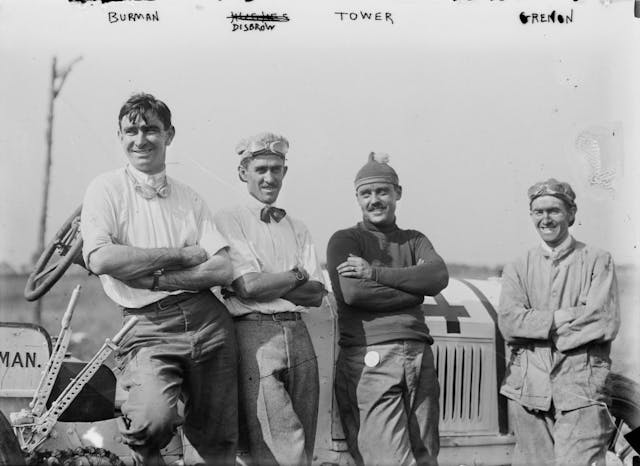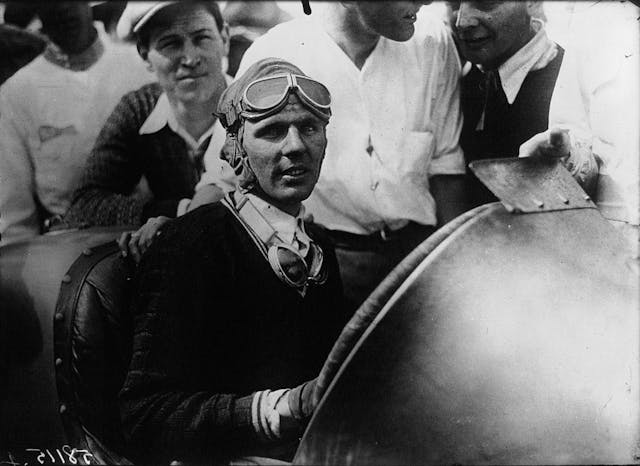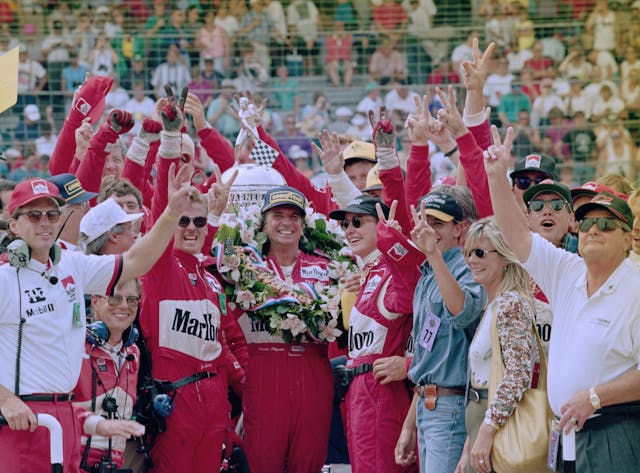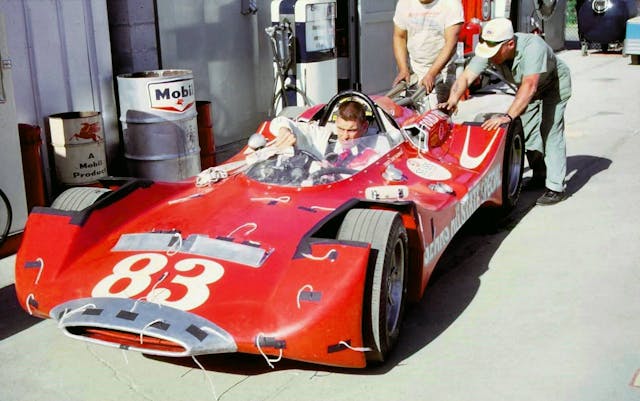Memorable moments from the Indianapolis 500
As the Greatest Spectacle in Racing, the Indianapolis 500 has lived up to its name during its 111-year history and provided fans with some of the most amazing moments in all of racing. Herewith is one writer’s list; they are not listed in any order, whether from good to best or chronologically. These are one fan’s subjectively memorable moments. What are yours? Let us know in the comments section below.
The 1911 500-mile race

The first 500-mile race was not actually called the Indianapolis 500; it was known as the International Sweepstakes. The race was held on May 30, 1911, with 40 cars on the grid and 56 participating drivers (back then, it was legal for a team to change the driver of a car); a crowd estimated as high as 85,000 was in attendance. The race lasted six hours and 42 minutes and was won by Ray Harroun piloting a Marmon Wasp and averaging 74.602 mph. Not only was Harroun the winning driver, but he also had helped design the Wasp, since he worked in the engineering department of Marmon, an Indianapolis-based automaker. When other teams objected during practice that Harroun’s single-seat racer did not allow for the riding mechanic that cars of the era normally carried, Harroun installed a rearview mirror on the cowling of his car. It is commonly accepted as the very first rearview mirror ever used on an automobile.
The 1911 race saw another first, when one of the Speedway’s founders, Carl G. Fisher, led the field on an unscored lap in his Stoddard-Dayton (the era’s equivalent of a sports car). Fisher then released the field to the starter at a speed of approximately 40 mph. This is believed to be the first-ever example of a rolling start for any automobile race in the world, and likely the first use of a pace car at such a major event.
Louis Meyer drinks some (butter) milk

After Meyer won his third Indy 500 in 1936, he needed something refreshing to quench his thirst in Victory Lane. Buttermilk was Meyer’s preferred drink of choice, so he downed a celebratory bottle. After a photograph of the event appeared in newspapers, an executive at the Milk Foundation lobbied to make the practice become a tradition. It happened sporadically until 1956, when it became an official part of the post-race celebrations.
Emerson Fittipaldi won’t drink the milk

When Brazilian racer Emerson Fittipaldi won the 500 in 1993, he pulled his car into Victory Lane for his interview. When it came time to drink the celebratory milk, Fittipaldi refused. Instead, he drank orange juice, which he had provided himself (he was an orange-juice producer in his hometown of São Paulo) in order to promote the Brazilian citrus industry. Fittipaldi refused to even hold the bottle of milk and pushed it away at least three times. At the end of the interview and after the cameras were gone, Fittipaldi finally did sip from the bottle at the behest of his team owner, Roger Penske, but it was too late. The reaction by the media and fans was highly critical, leveling charges that Fittipaldi had snubbed the time-honored tradition for his own personal gain. The following week at the Milwaukee Mile, fans heckled and booed Fittipaldi during the driver introductions. It seemed to have worked: A few days after the race, he issued an apology and donated to charity the $5000 prize he had won from the American Dairy Association of Indiana for winning the 500.
George Bailey is the first to race a rear-engined car at Indy

Commissioned by the Gulf Oil Company and designed by the legendary Harry Miller, the Gulf-Miller Special was incredibly advanced—and expensive—for its time. Not only was it the first rear-engined car to take the grid at Indy, it also featured four-wheel drive, four-wheel disc brakes, side-mounted pontoon fuel tanks, and a supercharged six-cylinder Miller engine. Of the three cars that showed up at Indy in 1939, only the car piloted by former Hudson Motor Company test driver George Bailey qualified. Starting in sixth place, the car threw a valve on lap 18 and was out of the race.
George Bailey is the first driver of a rear-engined car to die at Indy
Sadly, the Gulf-Miller Special also went on to become the first rear-engined car to crash at Indy and kill its driver. George Bailey brought the car back in 1940, and during practice he either got up into the marbles or possibly the car’s crankshaft broke and locked up all four wheels, sending the car into a slide. As Bailey struggled to regain control, the car skidded sideways into a concrete wall. It spun back across the track, hit the inside guard rail and punctured the left-side exterior fuel tank, drenching Bailey with fuel. The car exploded and as it came to a stop, Bailey jumped out, on fire, and ran. He fell at least three times before Eddie Hoff, a Speedway photographer, caught up to Bailey and attempted to beat out the flames. Bailey died 45 minutes later.
The Lotus 38 is first rear-engined car to win at Indy
Having competed in 1963 with the Lotus 29 and in 1964 with the Lotus 34, the third time in 1965 would prove the charm for Colin Chapman, Jim Clark, and Team Lotus. An evolution of the cars that preceded it but now with a full aluminum monocoque, the Lotus 38 also featured a naturally aspirated DOHC 4.2-liter Ford V-8 fitted with a Hilborn fuel-injection setup good for around 500 horsepower. Clark qualified second with a four-lap average of 160.729 mph, becoming the first driver to officially top 160. A.J. Foyt, however, was right behind Clark and took the pole with an average of 161.233 mph in a slightly modified Lotus 34. Foyt also set a new one-lap record at Indy of 161.958 mph. But when the green flag dropped, the race was all Clark’s. The Flying Scot led all but 10 laps and won with only four cars on the lead lap; the rest of the field was at least two laps behind. The days of the front-engined dinosaurs were all but over; in fact, only four of the 1964 field’s 33 cars were front-engined roadsters. By 1967 there would be none.
Janet Guthrie becomes the first woman to race at the Indy 500

Before there was Lyn St. James or Sarah Fisher or Danica Patrick—and the many other women who followed—there was Janet Guthrie. After graduating with a degree in aerospace engineering from the University of Michigan, Janet Guthrie began racing in 1963 on the SCCA circuit campaigning a Jaguar XK140. By 1972, she was racing full time; her sports-car career included two class wins in the 12 Hours of Sebring. Competing in the 1976 World 600 (the predecessor to the Coca-Cola 600 at Charlotte Motor Speedway), Guthrie finished 15th and became the first woman to compete in a NASCAR Winston Cup superspeedway race. The following season, she became the first woman to compete in the Daytona 500, where she placed 12th overall and took the Rookie of the Year honor. She would go on to compete in 33 NASCAR races over four seasons. Indy called and Guthrie answered in 1977, where she competed and finished 29th after going out with engine troubles. She would compete in two more Indy 500s, placing ninth in 1978 while driving with a broken wrist.
Al Unser, Jr., wins closest Indy 500 in history
The 1992 Indianapolis 500 was one of the coldest on record, with temperatures in the 40s. The polesitter, Roberto Guerrero, didn’t even make it to the green flag; he had crashed while zig-zagging to put heat in his tires. A similar fate would befall other racing royalty such as Mario Andretti, Rick Mears, and Emerson Fittipaldi. The cold temperatures weren’t slowing down Michael Andretti, however, who roared around the track with top speeds at greater than 229 mph. Then what some have called the “Andretti Curse” struck: After leading for 160 laps and enjoying a lead of 28 seconds with just 11 laps left, Andretti’s Lola-Ford rolled to a stop between Turns 3 and 4, and his day came to an end. With Andretti out, the stage was set for one of the most exciting finishes in Indy history.
Al Unser, Jr., found himself in first place despite having endured blown engines throughout the month of May. Right behind Little Al (Al Unser, Sr., or “Big Al,” was also in the race) was Scott Goodyear. Goodyear, despite having started 33rd, had managed to charge through the field, avoiding spinouts and crashes, to find himself hard on Little Al’s tail. Goodyear bobbed and weaved across the track, trying desperately to get past Unser. Unser, in turn, feinted and parried furiously, trying to break any draft Goodyear might find. The crowd roared its approval, rising to its feet to cheer on the epic battle they were witnessing. When Al Jr. took the checkered flag, his margin of victory was 0.043 second, making it the closest finish in the history of the Indianapolis 500. As Al Jr. managed to say in Victory Lane as tears welled in his eyes, “You just don’t know what Indy means.”
Dave MacDonald and Eddie Sachs killed in 1964 race

There have been dark days throughout Indy’s history, but perhaps none as dark as the crash at the beginning of the 1964 race. It started with rookie Dave MacDonald’s car, which was owned and designed by hot-rodding legend Mickey Thompson. The car had raced in 1963 but had been updated with streamlined bodywork for 1964. The changes only made the car difficult to drive. As MacDonald passed Johnny Rutherford and Eddie Sachs on the first lap, Rutherford could see that MacDonald’s car was handling poorly. Rutherford would later recall thinking, “He’s either gonna win this thing or crash.” On the second lap, MacDonald’s car spun as it exited Turn 4. The car slid across the track and hit the inside wall, setting off a massive fireball. MacDonald’s car then slid back up the track. Sachs aimed for an opening along the outside wall, but MacDonald’s burning car slid into his path. Sachs broadsided it, causing a second explosion that killed Sachs instantly. With seven cars out and two drivers dead, miraculously no one in the crowd was seriously injured. The race was red-flagged (another cruel first) for an hour and 40 minutes. A.J. Foyt would eventually win. There was tremendous outcry over the horrific events, with newspapers and TV stations calling to end the race. In response, the race’s governing body mandated cars to carry less fuel and eliminated the use of gasoline, switching first to less-volatile methanol, and then later ethanol in 2006. Gasoline would return in 2012 with the use of E85 and its formula of 85 percent ethanol and 15 percent gas. Another change was the introduction, in 1965, of the use of fuel cells that utilized technology from military helicopters.
Patrick Bedard is the first (and last) automotive journalist to race at Indy
Longtime Car and Driver columnist (and today, Hagerty contributor) Patrick Bedard became the first automotive journalist to take the grid at Indy. In 1983, he started in the sixth row and went out in a crash after 25 laps. He would return in 1984 with a March powered by a turbocharged Buick V-6—the first use of such a Buick powerplant at Indy. He qualified 19th at 201.915 mph, and his teammate, Scott Brayton, saw 203.367 mph, making this the first time that cars with passenger-car-derived engines had qualified at more than 200 mph. On lap 58 of the race, Bedard suffered a monstrous crash in Turn 4. The car spun to the inside of the north short chute, slammed into the inside wall, flipped, and then barrel-rolled through the grass. The car broke into two major pieces—the tub with the cockpit and the engine/transmission unit. The track was strewn with debris, requiring an extended caution to clean up the incident. Bedard suffered a broken jaw and a major concussion, and mercifully recalls nothing of the accident. Bedard understandably did not return to racing but continued on at Car and Driver until he retired in 2009.
An Andretti is on the pole again for the first time in 33 years

The family’s patriarch, Mario, started his first Indy 500 in 1965; he placed third, took Rookie of the Year honors, and went on to win the series championship. He repeated the honor in 1966 and found himself on the pole in 1967. In 1969, he qualified second behind Foyt, dominated the second half of the race, and took the checkered flag. It would be his first and only victory there, despite 29 more attempts. Son Michael was unsuccessful in his 16 attempts, although he has completed the most laps and led the most laps of any driver who has never won. His team, Andretti Autosport, however, has won six times at Indy. Mario’s other son, Jeff, has qualified for Indy three times. Mario’s nephew, John (son of Mario’s twin brother, Aldo), has 12 starts at Indy, placing as high as fifth. Grandson Marco has qualified 15 times and has taken the pole for this year’s 500, rescheduled for August 23. Seeing how Marco is 33 years old, it is the first time an Andretti has been on the pole since he was born. Will the Andretti Curse be lifted after all these years? Tune in Sunday to find out.

